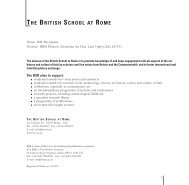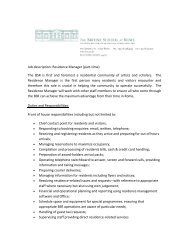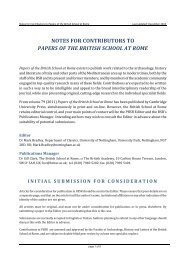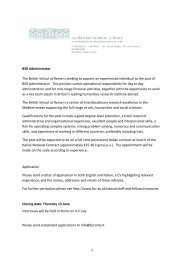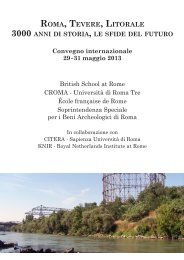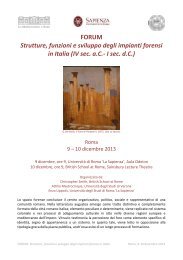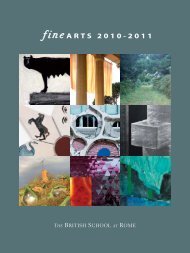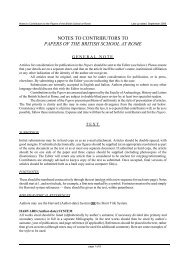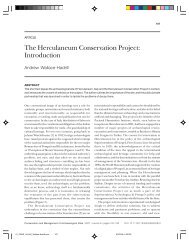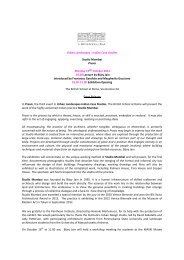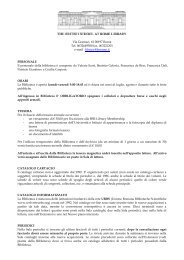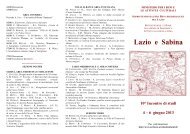Torino britannica. - The British School at Rome
Torino britannica. - The British School at Rome
Torino britannica. - The British School at Rome
Create successful ePaper yourself
Turn your PDF publications into a flip-book with our unique Google optimized e-Paper software.
<strong>Torino</strong> <strong>britannica</strong>.<br />
Political and Cultural<br />
Crossroads in the Age of<br />
the Grand Tour<br />
19 / 20 / 21 giugno 2013<br />
<strong>Rome</strong>, <strong>British</strong> <strong>School</strong> <strong>at</strong> <strong>Rome</strong><br />
Reggia di Venaria
Paola Bianchi<br />
Cosmopolitismo e pragm<strong>at</strong>ismo confessionale:<br />
i gentiluomini britannici in Accademia Reale<br />
L’Accademia Reale di <strong>Torino</strong> si profilò come un autentico crogiolo di esperienze cosmopolite. La<br />
fisionomia di tale istituto di formazione sarebbe cambi<strong>at</strong>a profondamente dopo la crisi dell’antico<br />
regime, divenendo una scuola militare a car<strong>at</strong>tere “nazionale”. Dall’apertura tardo-secentesca,<br />
ma sopr<strong>at</strong>tutto nel corso del Settecento, la fortuna a <strong>Torino</strong> di questo tipico esempio di<br />
Ritterakademie fu invece aliment<strong>at</strong>a dal flusso di una popolazione studentesca che, a differenza<br />
della committenza dell’<strong>at</strong>eneo e del Collegio dei Nobili, comprendeva anche gentiluomini di<br />
confessione protestante. Si tr<strong>at</strong>tò di un innesto di presenze interessanti, sotto l’aspetto sociale<br />
non meno che per il retroterra dei cont<strong>at</strong>ti internazionali, inserito in un tessuto urbano che già<br />
da tempo aveva assistito all’insediamento di commercianti, banchieri e militari di religione<br />
riform<strong>at</strong>a. Le vicende leg<strong>at</strong>e alla guerra della Lega di Augusta, intrecciandosi con le conseguenze<br />
della revoca dell’editto di Nantes nella Francia di Luigi XIV (1685), avevano port<strong>at</strong>o lo St<strong>at</strong>o<br />
sabaudo a una nuova str<strong>at</strong>egia di alleanze, che coinvolsero l’Inghilterra anglicana e le Province<br />
unite calviniste: una mossa che ebbe precisi risvolti sui rapporti con le enclaves protestanti. Tutto<br />
ciò si riverberò anche sull’afflusso di giovani aristocr<strong>at</strong>ici in Accademia Reale, a stretto cont<strong>at</strong>to<br />
con gli ambienti di corte, con i gabinetti diplom<strong>at</strong>ici e con i luoghi della sociabilità aristocr<strong>at</strong>ica.<br />
L’esistenza di cappelle di culto priv<strong>at</strong>o, presso le abitazioni scelte dagli invi<strong>at</strong>i, e alcune figure di<br />
diplom<strong>at</strong>ici d’origine ugonotta, pass<strong>at</strong>i al servizio inglese e giunti quindi in Piemonte per conto<br />
del re d’Inghilterra, costituirono, in tal senso, un tramite importante. Il saggio è volto a ricostruire<br />
il quadro di un dinamico e pragm<strong>at</strong>ico ambiente di relazioni in cui la promiscuità confessionale<br />
non rappresentò un ostacolo né un’eccezione troppo vistosa.<br />
Paola Bianchi, PhD in Storia della società europea (Storia moderna), è ricerc<strong>at</strong>rice presso<br />
l’Università della Valle d’Aosta dove insegna Storia dell’Europa. Si occupa di storia militare<br />
e di rapporti fra le corti europee, in particolare nel Sei e Settecento. Da anni studia i cont<strong>at</strong>ti<br />
cre<strong>at</strong>i dalla pr<strong>at</strong>ica del grand tour fra élites britanniche e St<strong>at</strong>o sabaudo, analizzando l’afflusso di<br />
gentiluomini in Accademia Reale a <strong>Torino</strong>, istituto che una tradizione storiografica di m<strong>at</strong>rice<br />
otto-novecentesca aveva teso a oscurare. Autrice di diversi saggi dedic<strong>at</strong>i a questi temi, ha avuto<br />
occasione di presentare alcuni risult<strong>at</strong>i dei suoi studi in una conferenza tenuta presso la <strong>British</strong><br />
Schoool <strong>at</strong> <strong>Rome</strong> nel marzo 2013, dal titolo Il viaggio in Italia in cerca del moderno. Gentiluomini<br />
inglesi a <strong>Torino</strong> nel Settecento / A Voyage to Italy in Search of Modernity: English Gentlemen in<br />
Eighteenth-Century Turin.
Cristina Bracchi<br />
Baretti inglese: la did<strong>at</strong>tica e la critica<br />
Lo studio dell’opera An Account of the Manners and Customs of Italy; with Observ<strong>at</strong>ions on<br />
the Mistakes of some Travellers with regard to th<strong>at</strong> Country, di Giuseppe Baretti, Londra 1768,<br />
consente di mettere a tema gli ambiti prevalenti dell’erudizione barettiana: la did<strong>at</strong>tica e la<br />
critica. L’Account, ampio resoconto di usi e costumi italiani, in risposta e contrapposizione alle<br />
relazioni di viaggio inglesi in Italia, offre un contributo, che si esplica oltre la lettera del testo,<br />
allo studio della storia dei rapporti tra cultura inglese e cultura italiana nel XVIII secolo. L’autore<br />
dichiara chiaramente le proprie intenzioni: “In the following work I censure with gre<strong>at</strong> freedom<br />
the accounts given of Italy by several English and several foreign writers of travels”.<br />
La diversità e la molteplicità di argomenti danno all’opera un car<strong>at</strong>tere enciclopedico e<br />
l’approfondimento dei temi letterari, su cui Baretti insiste con particolare enfasi, spiega la<br />
prospettiva critico-didascalica che presiede alla scelta di un ‘canone di personalità d’eccezione’<br />
della letter<strong>at</strong>ura italiana, da presentare con l’autorevolezza di un discorso <strong>at</strong>torno alla letter<strong>at</strong>ura<br />
che si avvale dell’intertestualità plurilingue che percorre tutta l’<strong>at</strong>tività di scrittura barettiana. Il<br />
d<strong>at</strong>o letterario, insieme agli aspetti odeporici, risulta sostenere la struttura dell’Account e, insieme<br />
all’educazione, al divertimento, alla religione, alla vita quotidiana, è fondamentale all’immagine<br />
dell’Italia e al genio italico che Baretti si prefigge di illustrare agli inglesi.<br />
Opera di n<strong>at</strong>ura composita, l’Account si presenta come un viaggio etnografico fra le realtà italiane.<br />
Tre sono le linee di svolgimento della volontà medi<strong>at</strong>rice di Baretti, in dialogo costante con le altre<br />
sue opere odeporiche, didascaliche, critiche: fornire una più precisa conoscenza del proprio paese<br />
fra gli/le inglesi; rinnovare la prestigiosa presenza culturale e civile dell’Italia in Europa, colmare in<br />
se stesso il vuoto d’identità dovuto alla condizione di emigr<strong>at</strong>o. Letter<strong>at</strong>ura e viaggio da mettere in<br />
relazione con il legame tra scrittura e vita, presente nel pragm<strong>at</strong>ismo barettiano.<br />
Cristina Bracchi, è insegnante e studiosa di letter<strong>at</strong>ura italiana e l<strong>at</strong>ina. Dottore di ricerca in<br />
Storia della lingua e della letter<strong>at</strong>ura italiana, si occupa in particolare di teoria e critica del testo,<br />
di storia della cultura e di teoria della ricezione; di letter<strong>at</strong>ura delle donne, nell’ambito degli<br />
studi di genere; di linguaggio e di italiano L2. Fa parte della Società Italiana delle Letter<strong>at</strong>e -<br />
SIL; degli Archivi delle Donne in Piemonte - ARDP; del Centro Interdisciplinare di Ricerche e<br />
Studi delle Donne - C.I.R.S.D.e dell’Università di <strong>Torino</strong>. Tra le sue pubblicazioni: Prospettiva<br />
di una nazione di nazioni. An Account of the Manners and Customs of Italy di Giuseppe Baretti,<br />
Alessandria, Edizioni dell’Orso, 1998; Le carte socr<strong>at</strong>iche della poesia. L’otium critico settecentesco e<br />
il canone oraziano, <strong>Torino</strong>, Thélème Editrice, 2001; Poetiche politiche. Narr<strong>at</strong>ive, storie e studi delle<br />
donne, a cura di C. Bracchi, Padova, Il Poligrafo, 2011.
Edward Chaney<br />
<strong>Torino</strong> Britannica and the Cultural Memory of Egypt:<br />
Stuarts, Savoys and the Divine Right of Kings.<br />
My paper begins by investig<strong>at</strong>ing early-seventeenth-century Anglo-Torinese connections and<br />
possible links with the so-called Mensa Isiaca, an artefact of gre<strong>at</strong> prestige in this period. At<br />
around the time Charles I acquired most of the rest of the Gonzaga collection, this seems to<br />
have been acquired by Carlo Emmanuele I of Savoy. <strong>The</strong> subject of a learned tre<strong>at</strong>ise published<br />
by Lorenzo Pignoria in 1605, until Champollion deciphered the hieroglyphics and Drovetti gre<strong>at</strong>ly<br />
enlarged the collection, the Mensa Isiaca starred as the prize exhibit and inspir<strong>at</strong>ion for wh<strong>at</strong><br />
became one of the gre<strong>at</strong>est Egyptian Museums in the world. ‘<strong>Torino</strong> Britannica and the Cultural<br />
Memory of Egypt’ is a two-stranded essay which examines the Divine Right of Kings as the legacy<br />
of ancient Egypt. <strong>The</strong> extent to which the Stuarts and the Dukes of Savoy, ever-anxious to acquire<br />
similarly regal st<strong>at</strong>us, were influenced by Egyptian ideas was for the most part unconscious<br />
but growing post-medieval interest in the visible manifest<strong>at</strong>ions of this still largely buried<br />
civiliz<strong>at</strong>ion tells us much about our own (and its discontents). More specifically it cre<strong>at</strong>es a new<br />
prism through which to investig<strong>at</strong>e the evolution of the United Kingdom and united Italy.<br />
Edward Chaney is the Professor of Fine and Decor<strong>at</strong>ive Arts and Founding Chair of the<br />
History of Collecting Research Centre <strong>at</strong> Southampton Solent University. He is author of several<br />
books on Anglo-Italian subjects and is a Commend<strong>at</strong>ore of the Italian Republic. In 2010-12 he<br />
was awarded a Leverhulme Major Research Fellowship to work on the Idea of Ancient Egypt in<br />
Early Modern Britain.
Annarita Coltur<strong>at</strong>o<br />
Con talento e intraprendenza:<br />
musicisti piemontesi a Londra nel secondo Settecento<br />
«<strong>The</strong> arrival of Giardini in London, in the spring of this year, forms a memorable æra in the<br />
instrumental music of this kingdom», scriveva Charles Burney nella sua General History of<br />
Music d<strong>at</strong>ando l’esordio inglese di Felice Giardini al 1750 anziché – come sembra certo – al<br />
1751. Grazie all’immedi<strong>at</strong>o successo come violinista e did<strong>at</strong>ta, al car<strong>at</strong>tere intraprendente e al<br />
sostegno di alcuni dei più influenti nomi dell’aristocrazia <strong>britannica</strong>, il compositore (<strong>Torino</strong>, 1716<br />
- Mosca, 1796) fu tra le personalità che dal punto di vista concertistico ed editoriale segnarono<br />
maggiormente il secondo Settecento musicale londinese. Non l’unico, a provenire dal Regno<br />
di Sardegna e dalle nutrite file degli strumentisti piemontesi noti in ambito internazionale per<br />
il loro virtuosismo e le loro qualità interpret<strong>at</strong>ive. Nel 1767, a incantare il pubblico con il suo<br />
talento, popolare i c<strong>at</strong>aloghi degli editori con le sue composizioni e guidare l’orchestra del King’s<br />
<strong>The</strong><strong>at</strong>re (avvi<strong>at</strong>a da Giardini a una «new discipline, and a new style of playing», stando ancora a<br />
Burney) giunse Gaetano Pugnani (<strong>Torino</strong>, 1731-1798), come Giardini allievo del ‘padre’ della scuola<br />
violinistica piemontese, Giovanni B<strong>at</strong>tista Somis: una scuola la cui fama in Europa, Inghilterra<br />
compresa, fu definitivamente decret<strong>at</strong>a da Giovanni B<strong>at</strong>tista Viotti (Fontanetto Po, Vercelli, 1755),<br />
«the celebr<strong>at</strong>ed Viotti, supposed to be the first Violin in the world» – come scrisse il celebre<br />
impresario Johann Peter Salomon – che proprio nella capitale inglese morì nel 1824 al termine di<br />
un’esistenza avventurosa trascorsa sulle ribalte più prestigiose e a cont<strong>at</strong>to con gli ambienti più<br />
colti e aristocr<strong>at</strong>ici del tempo.<br />
Annarita Coltur<strong>at</strong>o è ricerc<strong>at</strong>rice presso l’Università di <strong>Torino</strong> (Dipartimento di Studi<br />
Umanistici), dove insegna Bibliografia musicale. Membro del comit<strong>at</strong>o di redazione di «Fonti<br />
musicali italiane» (periodico della Società Italiana di Musicologia), del consiglio direttivo<br />
dell’Istituto per i Beni Musicali in Piemonte e del comit<strong>at</strong>o scientifico dell’orchestra Academia<br />
Montis Regalis, responsabile di vari progetti di ricerca, ha f<strong>at</strong>to parte dei comit<strong>at</strong>i scientifici<br />
di mostre e convegni. Ha cur<strong>at</strong>o i c<strong>at</strong>aloghi di fondi musicali di rilevanza internazionale,<br />
collabor<strong>at</strong>o ad alcune delle più autorevoli opere collettive di ambito musicale, dedic<strong>at</strong>o<br />
numerosi studi in particolare al Settecento musicale italiano (l’ultima monografia, Mettere in<br />
scena la regalità. Le feste te<strong>at</strong>rali di Gaetano Pugnani al Regio di <strong>Torino</strong>, è uscita nel 2012).
Paolo Cornaglia<br />
Il giardino inglese in Piemonte a fine Settecento:<br />
declinazioni pittoresche, anglo-cinesi e paesaggistiche.<br />
Nel suo Coup d’oeil sur Beloil, pubblic<strong>at</strong>o nel 1786, il principe de Ligne, testimone d’eccezione<br />
e in presa diretta del diffondersi del gusto pittoresco in Europa, stronca con poche parole la<br />
secolare vicenda dei giardini alla francese: “Alberi esausti, carpinete languenti, sentieri ar<strong>at</strong>i<br />
dove è impossibile passaggiare, una verzura mal<strong>at</strong>iccia, fieno al posto del pr<strong>at</strong>o”. È la nuova<br />
sensibilità nei confronti della n<strong>at</strong>ura che nei decenni procedenti è m<strong>at</strong>ur<strong>at</strong>a in Gran Bretagna e<br />
in quel momento sta guadagnando posizione grazie anche alla diffusione di modelli <strong>at</strong>traverso<br />
pubblicazioni come i ventuno cahiers (1775-89) dei Jardins Anglo-chinois di Le Rouge. Il nuovo<br />
spirito del giardino inglese giunge in Piemonte <strong>at</strong>traverso queste pubblicazioni ma anche<br />
<strong>at</strong>traverso l’osmosi con i paesi confinanti o specifici apporti leg<strong>at</strong>i al Regno Unito. Se una<br />
diretta influenza <strong>britannica</strong> è costituita dal progetto di Giovanni B<strong>at</strong>tista Borra (<strong>at</strong>tivo a Norfolk<br />
House a Londra e nel parco di Stowe) per il castello di Racconigi in forma di vera e propria villa<br />
inglese (1755), giardini ufficialmente “anglo-cinesi” o comunque pittoreschi o sono progett<strong>at</strong>i<br />
da Gugliemo Gullini nel 1784 per i Villa a Villastellone, da Giacomo Pregliasco nel 1787 per i<br />
Carignano a Racconigi e da Leopoldo Pollack (<strong>at</strong>tivo nel Lombardo-Veneto austriaco) nel 1796 per<br />
Faustina Mazzetti a Riva di Chieri. Un apporto diretto dalla Gran Bretagna, in ambito strettamente<br />
leg<strong>at</strong>o al progetto di giardino, si registra però a fine secolo: per i già cit<strong>at</strong>i Villa di Villastellone<br />
lo scozzese John Wallace interviene tra il 1784 e il 1804 con un doppio registro: un approccio<br />
pittoresco <strong>at</strong>tento alle fabriques per quanto riguarda la zona di parco adiacente alla villa e un<br />
grande respiro paesaggistico-rurale alla Capability Brown nel grandissimo parco circostante. Il<br />
nuovo secolo sarà poi te<strong>at</strong>ro dei grandi progetti paesaggistici del franco-tedesco Xavier Kurten,<br />
ma è già un capitolo successivo.<br />
Paolo Cornaglia, Architetto, Dottore di ricerca in Storia e critica dei Beni architettonici e<br />
ambientali, diplom<strong>at</strong>o all’Ecole des Hautes Etudes en Sciences Sociales di Parigi, è ricerc<strong>at</strong>ore<br />
presso il Dipartimento di Architettura e Design del Politecnico di <strong>Torino</strong>, presso il quale è<br />
docente di Storia dell’architettura e della città e di Storia dei giardini. Svolge <strong>at</strong>tività di ricerca<br />
sul tema della residenza nobiliare e di corte dal XVII al XIX secolo, focalizzando gli ambiti<br />
dell’architettura, della distribuzione, della decorazione e dei giardini. È inoltre consulente del<br />
Centro Studi del Consorzio La Venaria Reale.
Edward Corp<br />
<strong>The</strong> Court of Turin and the English Succession, 1712-1720<br />
<strong>The</strong> Bill of Rights of 1689, the Act of Settlement of 1701, and the Tre<strong>at</strong>y of Union (r<strong>at</strong>ified in 1707)<br />
excluded all C<strong>at</strong>holics from the succession to the <strong>British</strong> thrones and obliged the Stuart King<br />
James II and his family to live abroad in exile. Yet many people, both in the <strong>British</strong> Isles and in<br />
continental Europe, refused to accept this st<strong>at</strong>utory interference with the royal succession. For<br />
them, the Jacobites and their allies, James II was succeeded in 1701 by his son James III as the<br />
legitim<strong>at</strong>e King of England, Scotland and Ireland. James III was young and unmarried, but he had<br />
an elder half-sister (Queen Anne) and a younger sister (Princess Louise-Marie).<br />
<strong>The</strong> de<strong>at</strong>h in 1712 of James III’s younger sister, followed by the de<strong>at</strong>h of Queen Anne in 1714,<br />
meant th<strong>at</strong> Anna Maria, Duchess of Savoy, became the Jacobite heiress presumptive to the<br />
<strong>British</strong> thrones. She retained this position until the end of 1720 when James III’s wife, Queen<br />
Clementina, whom he had married the previous year, gave birth to Prince Charles, the first of their<br />
two sons. This paper will consider the <strong>at</strong>titude of Vittorio Amadeo, Duke of Savoy, to his wife’s (and<br />
his own two sons’) claim to the <strong>British</strong> thrones, and how it impacted on his rel<strong>at</strong>ions with James III<br />
during the short period when Vittorio Amadeo was also King of Sicily. Although dynastically linked<br />
and not unsymp<strong>at</strong>hetic to James, Vittorio Amadeo’s own ambitions conflicted with and were<br />
given priority over those of his wife. As one Jacobite put it in 1716, ‘the King of Sicily’s politics are<br />
more inclined to present preserv<strong>at</strong>ion than to future hopes’. In 1716-17, when James III was most<br />
vulnerable, Vittorio Amadeo refused all his requests for help. <strong>The</strong> King of Sicily was, however,<br />
prepared to help James get married, as th<strong>at</strong> might result in the birth of a Stuart prince to replace<br />
his wife Anna Maria as the Jacobite heiress.<br />
Edward Corp is Emeritus Professor of <strong>British</strong> History <strong>at</strong> the Universite de Toulouse [N.B.<br />
no accents on this keyboard]. His public<strong>at</strong>ions include <strong>The</strong> King over the W<strong>at</strong>er: Portraits of the<br />
Stuarts in Exile after 1689 (N<strong>at</strong>ional Galleries of Scotland, 2001) and a three volume history of<br />
the Jacobite courts: A Court in Exile: <strong>The</strong> Stuarts in France, 1689-1718 (Cambridge University<br />
Press, 2004), <strong>The</strong> Jacobites <strong>at</strong> Urbino (Palgrave Macmillan, 2009) and <strong>The</strong> Stuarts in Italy,<br />
1719-1766 (Cambridge University Press, 2011).
Paolo Cozzo<br />
“La metropolitaine des c<strong>at</strong>holiques”.<br />
La cappella dell’ambasci<strong>at</strong>a di Savoia nella Londra di Giorgio II.<br />
La relazione intende far luce sulla chiesa dell’ambasci<strong>at</strong>a sarda a Londra nel XVIII secolo. Il<br />
luogo di culto, aperto nella capitale <strong>britannica</strong> in concomitanza con l’acquisizione della corona<br />
di Sardegna da parte dei Savoia, divenne in breve tempo un punto di riferimento religioso non<br />
solo per i sudditi sabaudi, ma anche per i c<strong>at</strong>tolici londinesi. Qui inf<strong>at</strong>ti, più che in altre cappelle<br />
delle rappresentanze diplom<strong>at</strong>iche delle altre potenze c<strong>at</strong>toliche, quanti avevano continu<strong>at</strong>o<br />
ad essere fedeli alla Chiesa di Roma trovarono assistenza spirituale e personale ecclesiastico<br />
disponibile a soddisfare la varie esigenze (innazitutto di car<strong>at</strong>tere sacramentale) dconnesse alla<br />
vita religiosa. la funzione di chiesa parrocchiale assunta dalla cappella sabauda anche per molti<br />
sudditti britannici ne fece dunque un elemento assai signific<strong>at</strong>ivo nelle relazioni politiche e<br />
diplom<strong>at</strong>iche fra le due corti.<br />
Paolo Cozzo (Pinerolo, 1972) è ricerc<strong>at</strong>ore di Storia del Cristianesimo e delle Chiese presso la<br />
Facoltà di Scienze Politiche dell’Università di <strong>Torino</strong>. Il suoi interessi sono rivolti alla storia delle<br />
istituzioni ecclesiastiche e della vita religiosa in età moderna e contemporanea, con particolare<br />
<strong>at</strong>tenzione ai rapporti fra politica, religione e devozione negli st<strong>at</strong>i di Antico Regime.
Francesca Fedi<br />
Vittorio Alfieri e la «repubblica inglese»:<br />
riflessioni su un’affinità elettiva<br />
Nei suoi qu<strong>at</strong>tro viaggi in Inghilterra, tra il 1768 e il 1791, Vittorio Alfieri raccolse impressioni<br />
ed esperienze che diedero m<strong>at</strong>eria alla costruzione di un’immagine quasi ‘mitica’ del mondo<br />
britannico: immagine, peraltro, già deline<strong>at</strong>a nei suoi tr<strong>at</strong>ti essenziali negli anni della formazione,<br />
a <strong>Torino</strong>, e certo influenz<strong>at</strong>a (in positivo) dal confronto col modello di altre realtà ‘nazionali’, in<br />
primo luogo quella francese.<br />
La relazione si propone di interpretare gli episodi più signific<strong>at</strong>ivi dei soggiorni inglesi raccont<strong>at</strong>i<br />
nell’autobiografia di Alfieri, alla luce degli sviluppi del suo pensiero politico (segn<strong>at</strong>i in profondità<br />
dalla Rivoluzione Americana e da quella Francese, ma anche dalla riflessione sul retaggio<br />
della Glorious Revolution) e <strong>at</strong>traverso un’analisi il più possibile esaustiva della rete di rapporti<br />
stabiliti via via dal conte con diplom<strong>at</strong>ici, viaggi<strong>at</strong>ori, e personalità di rilievo nell’Inghilterra<br />
contemporanea.<br />
Francesca Fedi si è laure<strong>at</strong>a in Letter<strong>at</strong>ura Italiana a Pisa, perfezionandosi presso la Scuola<br />
Normale. Dopo un periodo di assistent<strong>at</strong>o a Zurigo ha insegn<strong>at</strong>o nei Licei e, dal 1998, presso<br />
l’Università di Parma. Dal dicembre 2012 è docente all’Università di Pisa.<br />
I suoi interessi di ricerca sono riconducibili alle linee seguenti: (1) utopia e paradosso nella<br />
cultura del primo Cinquecento, con particolare riguardo alle opere di Machiavelli; (2) letter<strong>at</strong>ura<br />
e te<strong>at</strong>ro nella Parma settecentesca; (3) cultura massonica e generi letterari in età illuministica<br />
(4) la poetica e l’estetica del Neoclassicismo; (5) la cultura figur<strong>at</strong>iva e il pensiero politico di<br />
Leopardi.
Christopher M. S. Johns<br />
Vanderbilt University<br />
Chinoiserie in Piedmont:<br />
An Intern<strong>at</strong>ional Language of Diplomacy and Modernity<br />
In 1713, as a result of the Tre<strong>at</strong>y of Utrecht th<strong>at</strong> ended the War of Spanish Succession, the House<br />
of Savoy obtained a prize it had sought for gener<strong>at</strong>ions: a royal title. Vittorio Amedeo II (reigned<br />
1684-1730) was recognized as King of Sicily, a title he had to exchange for the lesser kingdom of<br />
Sardinia in 1720, but he remained a king. To enhance the royal title and to place himself on par<br />
with other monarchs, Vittorio Amedeo began the transform<strong>at</strong>ion of his capital, Turin, into one<br />
of the most elegant and sophistic<strong>at</strong>ed cities of ancien régime Europe. This activity included the<br />
urbanistic renewal of the urban fabric and the construction of churches, palaces and chapels.<br />
When he abdic<strong>at</strong>ed in 1730, Turin was a major Italian city and a major stop on the Grand Tour.<br />
A notable fe<strong>at</strong>ure of the Savoyard dynasty’s cultural initi<strong>at</strong>ives is the inclusion of both interior and<br />
garden décor in the fashionable chinoiserie mode, a European exoticist idiom vaguely inspired by<br />
China. Chinoiserie was a Rococo style th<strong>at</strong> emphasized <strong>at</strong>tenu<strong>at</strong>ed human forms, rare plants and<br />
animals. It often included singeries, visually fusing Chinese and monkeys. This was done in part to<br />
establish a hierarchical rel<strong>at</strong>ionship between Europe and China th<strong>at</strong> favored the l<strong>at</strong>ter, especially<br />
after the Qing emperors closed the C<strong>at</strong>holic missions and refused to trade on equal terms with<br />
the West.<br />
Chinoiserie was popular in Italy, and Turin was its epicenter. Chinoiserie furniture, screens,<br />
paintings, silks, lacquer panels and garden ornaments, among other forms of visual culture,<br />
are ubiquitous in Savoyard sites: the Palazzo Reale, Venaria Reale, Palazzina della Caccia <strong>at</strong><br />
Stupinigi and Villa della Regina, among others. To the Piedmontese dynasty, chinoiserie signified<br />
current fashion, cultural sophistic<strong>at</strong>ion, global awareness and, above all, modernity. This paper<br />
investig<strong>at</strong>es the ubiquity of Piedmontese chinoiserie in the context of royal commissions and<br />
priv<strong>at</strong>e aristocr<strong>at</strong>ic p<strong>at</strong>ronage with an eye to understanding its popularity as a vital signifier<br />
of modernity. It also makes connections between <strong>British</strong> chinoiserie and its northwestern<br />
Italian counterpart in several media. My goal is to begin a discussion of chinoiserie th<strong>at</strong> goes<br />
beyond Rococo stylistic consider<strong>at</strong>ions and positions it in the intern<strong>at</strong>ional language of modern<br />
diplomacy and cultural exchange.<br />
Christopher M. S. Johns is Norman and Roselea Goldberg Professor of History of Art <strong>at</strong><br />
Vanderbilt University. His research interests include art, architecture and visual culture of the
eighteenth century. Johns is the author of four books: Papal Art and Cultural Politics: <strong>Rome</strong> in the<br />
Age of Clement XI (Cambridge: 1993); Antonio Canova and the Politics of P<strong>at</strong>ronage in Revolutionary<br />
and Napoleonic Europe (California: 1998); <strong>The</strong> Visual Culture of C<strong>at</strong>holic Enlightenment (Penn<br />
St<strong>at</strong>e: to appear in 2014); and China and the Church: Chinoiserie in Global Context (Washington: in<br />
press). He is a fellow of the Center for Advanced Study in Visual Art and the American Academy<br />
in <strong>Rome</strong>, where he was Resident in History of Art in 2004.
Christopher Alastair Laing<br />
A Plurality of Pluras:<br />
Members of the Plura Family and their Work for the <strong>British</strong><br />
A plurality of Pluras ? or just a triad ? - two (or three?) of whom worked in England. <strong>The</strong> first – who<br />
did not – was Carlo Giuseppe (1655-1737) of Lugano, a sculptor working in Turin in marble, wood,<br />
and even perhaps papier mâché. Next is the mysterious Plura who collabor<strong>at</strong>ed with the Ticinese<br />
stuccador Giovanni Bagutti <strong>at</strong> Castle Howard in 1711 – but seemingly worked nowhere else in<br />
Britain or on the Continent. Giuseppe, or Joseph ( ? – 1756), son of Carlo Giuseppe,seems to have<br />
trained as a sculptor in Turin, to which he was on the point of returning when he died. By 1749 he<br />
had come to B<strong>at</strong>h and married the daughter of a building contractor there. He is best known for<br />
the drawing-room group in marble of Diana and Endymion (1751; Holburne Museum of Art,B<strong>at</strong>h)<br />
th<strong>at</strong> he fruitlessly exhibited and advertised there and in London. His son, Joseph II (1753 - ? ),<br />
trained <strong>at</strong> the Royal Academy and worked for Nollekens, before going to Italy, where he visited<br />
Naples with Thomas Jones in 1778. Back in London in 1782, his last recorded act was to exhibit a<br />
“busto of the Abbé Grant <strong>at</strong> <strong>Rome</strong>” <strong>at</strong> the R.A. in 1786.<br />
Alastair Laing began by studying South German Rococo architecture and stucco, but since<br />
being one of the cur<strong>at</strong>ors of the François Boucher exhibition <strong>at</strong> the Met, the Detroit Institute of<br />
Arts, and the Grand Palais in Paris in 1986-87, and editor and main author of the c<strong>at</strong>alogue, he<br />
has devoted himself to th<strong>at</strong> artist. Between 1986 and 2013 he was Adviser/Cur<strong>at</strong>or of Pictures &<br />
Sculpture for the N<strong>at</strong>ional Trust, mounting its centenary exhibition, In Trust for the N<strong>at</strong>ion, <strong>at</strong><br />
the N<strong>at</strong>ional Gallery in 1995-96, and overseeing the public<strong>at</strong>ion of the 13,500-odd oil paintings<br />
in its houses for the Public C<strong>at</strong>alogue Found<strong>at</strong>ion (to be published in June).
Tommaso Manfredi<br />
Architetti e Re nell’Europa del Grand Tour: da Wren a Juvarra<br />
Nell’Europa degli st<strong>at</strong>i nazionali consolid<strong>at</strong>i alla fine del Seicento vi erano due diversi modelli di<br />
architetto regio, inteso come responsabile della gestione e della progettazione del p<strong>at</strong>rimonio<br />
della corona: quello francese e quello britannico, entrambi intrinseci ai rispettivi sistemi politici.<br />
Il Premier architecte du Roi, nella persona di Jules Hardouin-Mansart (in carica dal 1681 al 1708),<br />
era espressione del sistema di potere piramidale e burocr<strong>at</strong>ico consolid<strong>at</strong>o da Jean-Baptiste<br />
Colbert al tempo di Luigi XIV. Il Surveyor of the King’s Works, nella persona di Christopher Wren (in<br />
carica dal 1669 al 1718), rifletteva il car<strong>at</strong>tere meno accentr<strong>at</strong>o degli organi di governo britannici,<br />
coordinandosi con la figura del Comptroller of the King’s Works. Anche sul piano professionale<br />
vi erano profonde differenze tra questi due modelli. L’inglese Wren, scienzi<strong>at</strong>o di formazione,<br />
operava sperimentalmente senza il supporto di un sistema accademico disciplinare. Il francese<br />
Hardouin-Mansart guidava un appar<strong>at</strong>o estremamente specialistico e fortemente integr<strong>at</strong>o<br />
all’Académie Royale d’Architecture a lui sottoposta Anche per questo il Premier architecte di<br />
Luigi XIV costituì la figura di architetto regio esemplare per le corti assolutistiche dell’Europa<br />
continentale, compresa quella dei Savoia a <strong>Torino</strong>.<br />
Nel 1714 Vittorio Amedeo II di Savoia assegnò a Filippo Juvarra la carica di suo primo architetto,<br />
affidandogli un progetto artistico di lunga dur<strong>at</strong>a mir<strong>at</strong>o a esaltarne la nuova dignità regale sul<br />
piano interno e internazionale. Più di ogni altro architetto regio del Settecento, Juvarra ebbe la<br />
possibilità di confrontare la n<strong>at</strong>ura del suo ruolo nel contesto europeo viaggiando in Portogallo,<br />
Inghilterra, Francia e Spagna. Ciò offre lo spunto per una riflessione generale sull’identità e la<br />
funzione degli architetti regi nell’Europa del Grand Tour e sulla loro influenza nella definizione<br />
e nella diffusione dei linguaggi architettonici più aulici. Al contempo si intende offrire un’ampia<br />
panoramica sui processi di assunzione nel circuito internazionale degli architetti di corte, meno<br />
studi<strong>at</strong>o, ma non meno vivace e stimolante di quelli dei pittori e dei musicisti di cui Londra e<br />
<strong>Torino</strong> rappresentarono poli molto diversi, ma ugualmente signific<strong>at</strong>ivi.<br />
Tommaso Manfredi, architetto, svolge <strong>at</strong>tività did<strong>at</strong>tica e di ricerca presso l’Università<br />
Mediterranea di Reggio Calabria – Dipartimento P<strong>at</strong>rimonio, Architettura e Urbanistica. Si<br />
occupa di storia dell’architettura e della città in età moderna e contemporanea, con particolare<br />
riferimento a Francesco Borromini, Carlo Fontana, Filippo Juvarra, Ferdinando Fuga, Luigi<br />
Vanvitelli, Francesco Milizia, alla formazione degli architetti europei nel Settecento e<br />
nell’Ottocento, alla storia urbana di Roma, alla tr<strong>at</strong>t<strong>at</strong>istica del Seicento e del Settecento, su cui<br />
ha pubblic<strong>at</strong>o numerosi contributi. È autore delle monografie I Virtuosi al Pantheon. 1700-1758<br />
(con G. Bonaccorso, 1998), La costruzione dell’architetto. Maderno, Borromini, i Fontana e la<br />
formazione degli architetti ticinesi a Roma (2008); Filippo Juvarra. Gli anni giovanili (2010).
Andrea Merlotti<br />
Salotti, conversazioni, logge.<br />
I viaggi<strong>at</strong>ori inglesi nella sociabilità aristocr<strong>at</strong>ica torinese del Settecento<br />
I diplom<strong>at</strong>ici e i viaggi<strong>at</strong>ori inglesi a <strong>Torino</strong> parteciparono a diverse forme di sociabilità leg<strong>at</strong>e al<br />
car<strong>at</strong>tere fortemente cosmopolita della capitale sabauda. Nella seconda metà del XVIII secolo i<br />
salotti torinesi erano car<strong>at</strong>terizz<strong>at</strong>i, inf<strong>at</strong>ti, da una costante e nutrita presenza di esponenti delle<br />
aristocrazie europee; le accademie scientifiche e letterarie, i te<strong>at</strong>ri e, non ultima, la rete delle<br />
logge massoniche costituivano, inoltre, la trama di un fitto network di relazioni in cui la corte<br />
esercitava un’influenza indubbia, se pur indiretta. Lontana dall’essere car<strong>at</strong>terizz<strong>at</strong>a da una<br />
monotona sottomissione ai rigidi rituali di una società curiale periferica, come certa storiografia<br />
anche recente ha proposto, <strong>Torino</strong> rappresentava una meta ambita per molti gentlemen<br />
travellers. Le conversazioni ospit<strong>at</strong>e nei palazzi torinesi e organizz<strong>at</strong>e intorno a figure femminili<br />
del mondo nobiliare e alto borghese erano popol<strong>at</strong>e dai viaggi<strong>at</strong>ori stranieri, che manifestarono<br />
per tutto il corso del secolo grande interesse verso questa tipica espressione della sociabilità<br />
d’antico regime. L’intervento ripercorrerà il profilo dei principali <strong>at</strong>tori di questa scena posta in<br />
una signific<strong>at</strong>iva intersezione fra spazio pubblico e priv<strong>at</strong>o, riservando particolare <strong>at</strong>tenzione<br />
all’ambito massonico. Accanto a memorie di viaggi<strong>at</strong>ori e carteggi diplom<strong>at</strong>ici, la relazione<br />
utilizzerà documenti inediti che <strong>at</strong>testano la presenza di un nucleo di affiliazioni l<strong>at</strong>omiche<br />
m<strong>at</strong>ur<strong>at</strong>o in quell’Accademia Reale che era posta in stretta contiguità con gli ambienti della corte,<br />
dell’esercito e dell’internazionale aristocr<strong>at</strong>ica. Grazie a una documentazione finora ignota, è<br />
possibile individuare i primi probabili cont<strong>at</strong>ti massonici di diversi uomini di St<strong>at</strong>o e di lettere;<br />
basti citare il poeta e dramm<strong>at</strong>urgo piemontese Vittorio Alfieri, destin<strong>at</strong>o a percorrere “al rovescio”<br />
il viaggio di formazione in età ormai adulta e a incontrare in Inghilterra vecchi compagni di studi<br />
conosciuti a <strong>Torino</strong> negli “appartamenti” dell’Accademia Reale.<br />
Andrea Merlotti, conseguito nel 1997 il titolo di dottore di ricerca in Storia della società<br />
europea presso l’Università di <strong>Torino</strong>, dal 1998 al 2005 vi ha svolto <strong>at</strong>tività di post-dottor<strong>at</strong>o e di<br />
assegnista di ricerca. Ha al suo <strong>at</strong>tivo libri (fra cui L’enigma delle nobiltà. St<strong>at</strong>o e ceti dirigenti urbani<br />
nel Piemonte del Settecento, Firenze, Olschki, 2000), cur<strong>at</strong>ele (fra cui Nobiltà e St<strong>at</strong>o in Piemonte. I<br />
Ferrero d’Ormea, <strong>Torino</strong>, Zamorani, 2003; Le str<strong>at</strong>egie dell’apparenza. Cerimoniali, politica e società<br />
alla corte dei Savoia in età moderna, con P. Bianchi, ivi, 2010) e quasi ottanta saggi sulla storia dei<br />
Savoia, del loro St<strong>at</strong>o e dei ceti dirigenti subalpini. Dal 2008 dirige il Centro Studi della Reggia di<br />
Venaria ed è docente presso la Scuola di dottor<strong>at</strong>o (ScuDo) del Politecnico di <strong>Torino</strong>. Dal 2010 è
membro della Commissione scientifica sulle residenze reali della Regione Piemonte e rappresenta<br />
il Consorzio La Venaria Reale nel Court Studies Forum. All’<strong>at</strong>tività di storico negli ultimi anni ha<br />
unito quella di cur<strong>at</strong>ore di mostre: nel 2007-08 è st<strong>at</strong>o fra i cur<strong>at</strong>ori de La Reggia di Venaria e i<br />
Savoia; nel 2009-10 ha cur<strong>at</strong>o, con Alessandro Barbero, Cavalieri. Dai Templari a Napoleone e nel<br />
2011 con Clara Goria ha coordin<strong>at</strong>o scientificamente Moda in Italia. 150 anni di eleganza (tutte<br />
svoltesi presso la Reggia di Venaria). Sempre nel 2011 con Domenico De Gaetano ha cur<strong>at</strong>o la<br />
sezione Piemonte della mostra Regioni e testimonianze d’Italia (Roma, Vittoriano). Attualmente sta<br />
curando una mostra sulle carrozze delle corti italiane, che, organizz<strong>at</strong>a col Palazzo del Quirinale ed<br />
il Polo Museale Fiorentino, inaugurerà alla Reggia di Venaria nel settembre 2013. Sua ultima f<strong>at</strong>ica<br />
è la cura del volume La tavola di corte fra Cinque e Settecento (Roma, Bulzoni 2013).
Andrew Moore<br />
Thomas Coke: Playhouse, Rope Dancing and the Venaria Reale<br />
<strong>The</strong> context for this paper is the European tour of Thomas Coke, l<strong>at</strong>er 1st Earl of Leicester, who<br />
was abroad from 1712 – 1718. Thomas Coke’s European travels exemplify the impact th<strong>at</strong> the<br />
tour <strong>at</strong> this period could have upon not only early Georgian taste and architecture, but also th<strong>at</strong><br />
antiquity could have upon a young man educ<strong>at</strong>ed abroad <strong>at</strong> th<strong>at</strong> moment. <strong>The</strong> building of his new<br />
house <strong>at</strong> Holkham on the north-east coastal salt marshes in Norfolk is the outcome of Coke’s<br />
Tour. Coke spent a gre<strong>at</strong> deal on works of art whilst abroad, all purposed for his new se<strong>at</strong> in the<br />
country – a project th<strong>at</strong> gradually developed in his mind with every Roman palace he visited over<br />
the years 1714, 1716 and 1717 and as he progressed into m<strong>at</strong>urity.<br />
Turin and Piedmont are in a sense just one of a number of northern European cities and st<strong>at</strong>es<br />
becoming established by 1700 as classic centres for the Northern European traveller as they<br />
progressed to <strong>Rome</strong>. <strong>The</strong> early 1710s were a particularly vol<strong>at</strong>ile time for Turin and Piedmont.<br />
<strong>The</strong> city was being transformed under Victor Amadeus II, Duke of Savoy and Prince of Piedmont<br />
(1666-1732), also styled King of the Kingdom of the two Sicilies <strong>at</strong> this time. During Coke’s two<br />
visits in 1713 and 1714/15 Turin was therefore an impressive combin<strong>at</strong>ion of both French and<br />
Italian influence in architectural terms, while politically allied to the <strong>British</strong> and Habsburg lines.<br />
This was led to a seminal appreci<strong>at</strong>ion of architecture th<strong>at</strong> allowed for influence and individuality<br />
r<strong>at</strong>her than strict and rigorous interpret<strong>at</strong>ion of the Palladian model. Coke was l<strong>at</strong>er to visit both<br />
Naples and Sicily, effectively surveying a continu<strong>at</strong>ion of Habsburg influence in conjunction with<br />
th<strong>at</strong> of the House of Savoy. <strong>The</strong> paper explores how Edward Jarrett’s account books shed light<br />
on the importance of Turin and Piedmont in establishing the impact of the region on the young<br />
traveller.<br />
Andrew Moore, formerly Keeper of Art <strong>at</strong> Norwich Castle Museum & Art Gallery, now<br />
works for the Attingham Trust for the study of historic houses and collections, as Director<br />
of the Attingham Summer <strong>School</strong>. He has cur<strong>at</strong>ed or co-cur<strong>at</strong>ed a number of exhibitions,<br />
accompanied by public<strong>at</strong>ions including regional assessments of the Grand Tour (1985); the<br />
influence of Dutch and Flemish painting (1988); Portraiture (1992). In partnership with the St<strong>at</strong>e<br />
Hermitage Museum, St. Petersburg he published the collection of Sir Robert Walpole, A Capital<br />
Collection (Yale University Press, 2002). He is currently researching the Grand Tour of Thomas<br />
Coke. In 2007 he was Paul Mellon Senior Fellow <strong>at</strong> the <strong>British</strong> <strong>School</strong> <strong>at</strong> <strong>Rome</strong>.
Toby Osborne<br />
<strong>The</strong> House of Savoy and the Stuarts:<br />
a dynastic context to cultural rel<strong>at</strong>ions<br />
<strong>The</strong> accession of the Stuarts to the English throne has often been taken as a turning point in<br />
the history of collecting in Britain, highlighting the importance of the dynastic context to art and<br />
cultural history. Peace with Spain in 1604, a succession of C<strong>at</strong>holic queens, and more intense<br />
diplom<strong>at</strong>ic contact with C<strong>at</strong>holic courts, facilit<strong>at</strong>ed gre<strong>at</strong>er cultural interest in continental<br />
Europe. This interest was additionally driven by courtiers and diplom<strong>at</strong>s, as increasing numbers<br />
of <strong>British</strong> subjects experienced travel abroad. While much scholarly <strong>at</strong>tention has focused on<br />
the impact of cultural rel<strong>at</strong>ions with the Spanish Habsburg courts, and with Venice, there was a<br />
corresponding growth in rel<strong>at</strong>ions with the Savoyard court. Indeed, during the first decades of<br />
the seventeenth century the first two Stuart kings, James I and Charles I, in particular, looked on<br />
Savoy as something like a n<strong>at</strong>ural dynastic ally, despite the confessional differences between<br />
their st<strong>at</strong>es. This paper examines the n<strong>at</strong>ure of deepening rel<strong>at</strong>ions between the Stuarts and<br />
Savoys in the first half of the seventeenth century, as a backdrop to cultural contact between<br />
their respective st<strong>at</strong>es.<br />
Toby Osborne (Balliol College, Oxford, BA, 1990, D.Phil, 1996), taught <strong>at</strong> Warwick and Oxford<br />
before taking up his current position <strong>at</strong> the University of Durham in 1996. He is interested in<br />
the House of Savoy in an intern<strong>at</strong>ional context, early-modern diplom<strong>at</strong>ic culture, and the papal<br />
court. He is currently completing a general book on the papal court, and is running a research<br />
network on cross-cultural diplomacy in the early-modern period. In a third strand of research,<br />
he is working on a research monograph on royalty in Italy, with a focus on the House of Savoy,<br />
the Medici and Venice.
Andrea Pennini<br />
Un’altra via possibile?<br />
i progetti m<strong>at</strong>rimoniali anglo-sabaudi nel primo Seicento.<br />
Durante i negozi<strong>at</strong>i anglo-spagnoli di inizio XVII secolo, il leg<strong>at</strong>o sabaudo presso la corte pontificia<br />
Filiberto Gherardo Scaglia conte di Verrua prospetta a Carlo Emanuele I la possibilità di contrarre<br />
un duplice m<strong>at</strong>rimonio tra Savoia e Stuart: il primo tra Vittorio Amedeo e la principessa Elizabeth,<br />
il secondo tra il principe di Galles Henry e una delle infanti di Savoia. Qualche anno più tardi, nel<br />
suo “testamento politico”, lo stesso duca sostiene che il m<strong>at</strong>rimonio anglo-sabaudo sia un’ottima<br />
opportunità per una delle principesse più giovani (Maria e C<strong>at</strong>erina). L’ipotesi nuziale d’oltre<br />
Manica, sempre presente nella mente di Carlo Emanuele, non dà luogo ad alcuna tr<strong>at</strong>t<strong>at</strong>iva, in<br />
quanto vengono preferite ad essa strade più “tradizionali”. La svolta avviene all’indomani del<br />
fallimento del tr<strong>at</strong>t<strong>at</strong>o di Bruzolo quando la corte di <strong>Torino</strong> si trova stretta tra l’ostilità francese e<br />
la diffidenza spagnola e ricerca soluzioni altern<strong>at</strong>ive, tra cui spicca quella <strong>britannica</strong>.<br />
Le tr<strong>at</strong>t<strong>at</strong>ive m<strong>at</strong>rimoniali tra il duca di Savoia e il re d’Inghilterra hanno luogo tra il 1611 e il 1614<br />
ed interessano in un primo momento il principe di Piemonte e la principessa Elizabeth. Fallito<br />
questo primo tent<strong>at</strong>ivo, si procede con il negozi<strong>at</strong>o per le nozze di Maria di Savoia con il principe<br />
del Galles. La morte prem<strong>at</strong>ura di quest’ultimo e il conseguente passaggio del titolo di erede<br />
al trono al fr<strong>at</strong>ello Carlo di sei anni più giovane complica notevolmente la buona riuscita del<br />
negozi<strong>at</strong>o, fino al fallimento.<br />
In poco meno di tre anni si alternano a Londra qu<strong>at</strong>tro leg<strong>at</strong>i sabaudi (il conte Claudio Cambiano<br />
di Ruffia, Fulvio Pergamo, Giovanni B<strong>at</strong>tista Gabaleone e il marchese Francesco Villa) che – però<br />
– a causa delle differenze di religione, di prestigio dinastico e di aspett<strong>at</strong>ive economiche non<br />
riescono a concludere alcun tr<strong>at</strong>t<strong>at</strong>o. Tuttavia l’<strong>at</strong>tività diplom<strong>at</strong>ica svolta da questi invi<strong>at</strong>i porrà<br />
le basi per una solida amicizia che proseguirà, eccezion f<strong>at</strong>ta per gli anni di Cromwell, per tutta la<br />
prima età moderna.<br />
Andrea Pennini è assegnista di ricerca presso il Dipartimento di Giurisprudenza<br />
dell’Università di <strong>Torino</strong>. Si è laure<strong>at</strong>o nel 2008 presso l’Università di <strong>Torino</strong> e nel 2012 ha<br />
conseguito il titolo di dottore di ricerca presso l’Università del Piemonte Orientale sotto la guida<br />
del prof. Claudio Rosso. Si occupa principalmente della diplomazia sabauda nella prima età<br />
moderna e della ricostruzione degli ordini religiosi nell’età della Restaurazione.
Edoardo Piccoli<br />
Artigiani, fortificazioni, vigne. Inglesi in città intorno al 1748<br />
Sulla scorta dell’interesse non solo narr<strong>at</strong>ivo che la storiografia recente ha avuto per le città<br />
dell’«accueil» e del viaggio europee, e tentando di aggirare le lacune documentarie che limitano<br />
le informazioni sugli stranieri nella capitale sabauda, proponiamo di spostare l’<strong>at</strong>tenzione sulla<br />
città e i suoi spazi, nei decenni centrali del secolo XVIII.<br />
Città capitale, città di corte, porta dell’Italia, città-fortezza; per la comunità di stranieri delle<br />
“three n<strong>at</strong>ions” <strong>Torino</strong> è a metà Settecento un luogo di frequentazioni, usi ed esperienze piuttosto<br />
diverse tra loro. Quali sono i luoghi degli inglesi a <strong>Torino</strong>? Alberghi palazzi vigne, banchieri e<br />
negozi, fortificazioni e residenze Reali disegnano frammenti di una rete smagli<strong>at</strong>a e irregolare;<br />
una costellazione, non un territorio, in cui tuttavia è possibile riconoscere l’emergenza di una<br />
società urbana, non più soltanto di una corte. <strong>Torino</strong> è ormai una “large”, anche se non “gre<strong>at</strong>”, city,<br />
conta 65.000 abitanti e definisce un territorio polarizz<strong>at</strong>o, di ville e forti e chiese, di cui anche gli<br />
inglesi colgono l’estensione.<br />
L’esperienza dei singoli è a tr<strong>at</strong>ti illuminante, ma non sufficiente; alla fine degli anni 1740, con<br />
la fine di una guerra e la riapertura delle frontiere, una serie di passaggi incroci<strong>at</strong>i contente di<br />
cogliere un quadro più complesso e forse intelligibile. Militari, segretari, studenti e viaggi<strong>at</strong>ori<br />
(il Generale St. Clair, Lord Charlemont o David Hume), si muovono intorno ad alcuni fulcri - spazi<br />
precisi dentro e fuori le mura -, che ci proponiamo d’identificare. Luoghi, persone, ma anche<br />
economie sono messe in gioco dalla presenza di stranieri. Le carte di Thomas Wentworth<br />
(+ <strong>Torino</strong> 2 dic. 1747), spedite in p<strong>at</strong>ria dopo la sua morte improvvisa consentono di valutare<br />
l’imp<strong>at</strong>to di almeno un viaggi<strong>at</strong>ore di rango sulla città e le economie urbane.<br />
Edoardo Piccoli teaches Modern and Contemporary architecture <strong>at</strong> the Politecnico di<br />
<strong>Torino</strong>. He gradu<strong>at</strong>ed in Architecture <strong>at</strong> the same University, where he received a PhD in<br />
Architectural History. He has received a D.E.A. in Civilis<strong>at</strong>ion de la Renaissance from the<br />
Centre d’Etudes Supérieures de la Renaissance <strong>at</strong> Tours. His research focuses on 18th c.<br />
architecture. He has edited books and contributed essays to collective works and exhibition<br />
c<strong>at</strong>alogs. He is currently working on travelers in eighteenth-century Europe (with Emilio Mazza,<br />
Iulm Univ.), on the architecture of religious Orders (CRESO group) and on Bernardo Vittone<br />
(Istruzioni Elementari, 1760, repr. 2008).
James Rothwell<br />
Silver from London and Turin: <strong>The</strong> Collection of the 2nd Earl of Bristol,<br />
Envoy Extraordinary to the Court of Savoy 1755-58<br />
Sulla scorta dell’interesse non solo narr<strong>at</strong>ivo che la storiografia recente ha avuto per le città<br />
George William Hervey, 2 nd Earl of Bristol (1721-75) was bred for diplomacy. His parents were <strong>at</strong><br />
the heart of court life under George II and Queen Caroline and he was schooled in French from the<br />
age of five. He completed his studies in Geneva and travelled in Italy before returning to England<br />
in 1741. In 1755 he was sent to Turin as <strong>British</strong> Envoy and he brought with him a magnificent<br />
collection of silver, much of it recently acquired from th<strong>at</strong> most sculptural of London goldsmiths,<br />
Frederick Kandler. Lord Bristol’s success <strong>at</strong> the Court of Turin is <strong>at</strong>tested to by both <strong>British</strong> and<br />
Turinese sources and it combined with the demands of his office to require yet more silver,<br />
primarily for dining. With Turin’s goldsmiths then being amongst the finest in Europe, and in close<br />
contact with the fashions set in Paris, he did not have to look far and commissioned two of King<br />
Carlo Emmanuele III’s favoured makers, Andrea Boucheron and Paolo Antonio Paroletto. Some 70<br />
items of Turinese silver survive <strong>at</strong> the Hervey family se<strong>at</strong>, Ickworth in Suffolk, and must constitute<br />
one of the largest individual groups from the pre-Napoleonic period to survive anywhere in the<br />
world. With the survival also of his English purchases, and of copious diplom<strong>at</strong>ic correspondence<br />
in London and Turin covering a period which saw the outbreak of the Seven Years War, Lord Bristol<br />
is a valuable subject for the study of the political and cultural crossovers between London and<br />
Turin in the mid-eighteenth century.<br />
James Rothwell is a Senior Cur<strong>at</strong>or with the N<strong>at</strong>ional Trust and also acts as the Trust’s N<strong>at</strong>ional<br />
Adviser on Silver. He has undertaken extensive research on the subject of silver and was the<br />
joint author of the c<strong>at</strong>alogue of the renowned collection of pl<strong>at</strong>e <strong>at</strong> Dunham Massey, published<br />
in 2006. He is now concentr<strong>at</strong>ing on the silver <strong>at</strong> Ickworth, which constitutes one of the Trust’s<br />
most significant, and is working on a c<strong>at</strong>alogue of th<strong>at</strong> collection.
Cristina Ruggero<br />
Bibliotheca Hertziana, Roma<br />
L’album juvarriano per Lord Burlington a Ch<strong>at</strong>sworth<br />
Nel 1944 Rudolf Wittkower scopriva l’esistenza di «un piccolo libro di schizzi» nella collezione<br />
dei duchi del Devonshire (Ch<strong>at</strong>sworth) realizz<strong>at</strong>o da Filippo Juvarra (1678-1736), primo architetto<br />
dei Savoia, per lord Burlington (1694-1753). Il prezioso album è composto da 30 disegni di<br />
fantasie architettoniche, contrassegn<strong>at</strong>i dalla d<strong>at</strong>a «1729» e dalla firma «Cav. Juvarra», ai quali è<br />
anteposto un frontespizio con la seguente iscrizione: «PROSPETIVE DISEGIATE DALL CAVAL DON<br />
FILIPPO YUVARRA E DEDICATE All ’Eccellenza di Riccardo Conte di Burlington MDCCXXX».<br />
Dopo i due saggi pubblic<strong>at</strong>i da Wittkower nel 1949 e nel 1975 l’album non ha più suscit<strong>at</strong>o un<br />
interesse scientifico, forse proprio a causa del giudizio espresso dallo studioso tedesco: «Il<br />
volume di Ch<strong>at</strong>sworth […] non ci presenta niente di nuovo né riguardo all’invenzione, né riguardo<br />
allo stile. Invece la dedica ha un interesse tutto particolare».<br />
In questa sede si propone una lettura che, partendo dai due personaggi coinvolti, tiene conto<br />
delle idee sull’antico e sull’identità nazionale che si andavano coltivando in ‘Britannia’ nella prima<br />
metà del Settecento e che trovavano forti analogie politiche e culturali nella Roma repubblicana<br />
della quale si idealizzano i valori, ma sopr<strong>at</strong>tutto le virtù. Juvarra ha saputo interpretare questi<br />
ideali nelle prospettive architettoniche, traducendo nel disegno le sue molteplici conoscenze ed<br />
esperienze artistiche e andando ben oltre quell’apparente «agreeable disorder» evoc<strong>at</strong>o a prima<br />
vista dalle composizioni.<br />
Cristina Ruggero ha conseguito la laurea in storia dell’arte e la specializzazione in Germania<br />
(università di Freiburg im Breisgau e München). Attualmente è assistente scientifica presso<br />
la Bibliotheca Hertziana di Roma. Negli ultimi anni ha pubblic<strong>at</strong>o i risult<strong>at</strong>i dei suoi studi<br />
sull’opera di Filippo Juvarra particolarmente nel campo della grafica. Nel 2010 le è st<strong>at</strong>o<br />
assegn<strong>at</strong>o il Premio Hanno-und-Ilse-Hahn per la ricerca sull’arte del disegno e sulla scultura del<br />
XVII e XVIII.
Christopher Storrs<br />
<strong>The</strong> <strong>British</strong> Diplom<strong>at</strong>ic Presence in Turin, Diplom<strong>at</strong>ic Culture<br />
and <strong>British</strong> Elite Identity 1688-1789<br />
Britain’s emergence as a major European power following the “Glorious Revolution” was closely<br />
bound up with a new, much closer rel<strong>at</strong>ionship with the Savoyard st<strong>at</strong>e, which was often an ally<br />
in Britain’s eighteenth century wars against France. Associ<strong>at</strong>ed with this was a near permanent<br />
<strong>British</strong> diplom<strong>at</strong>ic presence in Turin. This paper seeks to do three things. (1) It explores <strong>British</strong><br />
represent<strong>at</strong>ion in the Savoyard capital in the eighteenth century in order to understand just how<br />
far <strong>British</strong> diplomacy fitted into the prevailing European diplom<strong>at</strong>ic culture. (2) But it also seeks to<br />
address just how far the diplom<strong>at</strong>ic experience contributed to developing notions of <strong>British</strong>ness,<br />
as libertarian and Protestant (in contrast with the C<strong>at</strong>holic, absolute Savoyard st<strong>at</strong>e) . (3) Finally,<br />
the paper looks <strong>at</strong> the way Britain’s diplom<strong>at</strong>s medi<strong>at</strong>ed between visiting Britons, many of them<br />
passin through on the Grand Tour, and the Savoyard Court and associ<strong>at</strong>ed institutions – above<br />
all the Turin academy – and in this way contributed to the spread among some sections of the<br />
<strong>British</strong> elites of European notions of nobility.<br />
Christopher Storrs gradu<strong>at</strong>ed with Honours in Modern History from the University of Oxford<br />
(St. C<strong>at</strong>herine’s College), and obtained his PhD from the University of London (London <strong>School</strong><br />
of Economics). His research interests centre on early modern Europe, and in particular on<br />
Spain and Italy (where he is especially interested in the Savoyard st<strong>at</strong>e). In terms of themes, he<br />
is particularly interested in intern<strong>at</strong>ional rel<strong>at</strong>ions (war and diplomacy), st<strong>at</strong>e form<strong>at</strong>ion and<br />
empire, and the nobility - or nobilities - of Europe in the same period. His public<strong>at</strong>ions include<br />
War, Diplomacy and the Rise of Savoy 1690-1720 (Cambridge, 1999), <strong>The</strong> Resilience of the Spanish<br />
Monarchy 1665-1700 (Oxford, 2006) and (as editor) <strong>The</strong> Fiscal-Military St<strong>at</strong>e in Eighteenth Century<br />
Europe (Farnham, 2009). Dr. Storrs is Reader in History in the <strong>School</strong> of Humanities <strong>at</strong> the<br />
University of Dundee.
Karin Wolfe<br />
John Molesworth: <strong>British</strong> Envoy and Cultural Intermediary in Turin<br />
<strong>The</strong> name of John Molesworth (1679-1726), <strong>British</strong> envoy to the Savoyard st<strong>at</strong>e from 1720-1725,<br />
first appears in the art historiography in 1757. In the second volume of his Raccolta di lettere<br />
pittoriche, Giovanni Gaetano Bottari published three of Molesworth’s letters - written to<br />
Francesco Maria Gabburri over the course of five months in 1724 - which Bottari deemed to<br />
represent the fruit of the knowledge of “a man of letters and of a highly refined discernment”<br />
(“uomo di lettere e di finissimo discernimento”). <strong>The</strong> letters in question critique a pictorial<br />
commission awarded the Florentine painter Tommaso Redi and show the lofty erudition and<br />
highly developed aesthetic taste th<strong>at</strong> Molesworth amply demonstr<strong>at</strong>ed during the course of his<br />
diplom<strong>at</strong>ic sojourn in Turin, where he was described by a contemporary traveller as “the delight<br />
of this whole court” (“qui fait les délices de cette Cour”). This paper will analyse the role played<br />
by Molesworth <strong>at</strong> the Savoy court as an intermediary of the vital cultural exchange taking place<br />
between Britain and Florence, the city which had left an indelible cultural imprint on Molesworth<br />
during his earlier residency there as envoy extraordinary to the Medici principality from 1711-1714.<br />
This context was the setting for the long rapport of both friendship and p<strong>at</strong>ronage th<strong>at</strong> developed<br />
between Molesworth and the Florentine architect Alessandro Galilei (1691-1737). <strong>The</strong> rel<strong>at</strong>ionship<br />
took root in Florence, progressed to England and Ireland when the architect moved there for five<br />
years beginning in 1714 upon the envoy’s urging when he left Italy, and then continued through<br />
Molesworth’s l<strong>at</strong>er residency in Turin, as can be documented by the surviving correspondence,<br />
published, in part, by Ilaria Toesca in 1952. A re-evalu<strong>at</strong>ion of this correspondence, pieced<br />
together with other contemporary sources, allows for a complete portrait of Molesworth to<br />
emerge as a modern “Virtuoso”. Connoisseur of painting, sculpture, architecture, music, and<br />
poetry – both ancient and contemporary - Molesworth’s cultural acumen m<strong>at</strong>ured in Turin,<br />
while he was in contact with the artists, scholars, European travellers and personalities who<br />
frequented and comprised the Savoy court, including first and foremost the royal architect and<br />
taste-maker, Filippo Juvarra.<br />
Karin Wolfe (M.A. PhD Courtauld Institute) is a Research Fellow <strong>at</strong> the <strong>British</strong> <strong>School</strong> <strong>at</strong> <strong>Rome</strong>.<br />
She has taught <strong>at</strong> Temple University and John Cabot University and has published on Roman<br />
seventeenth- and eighteenth-century p<strong>at</strong>ronage, art and the Grand Tour; including articles<br />
on Caravaggio, Cardinal Antonio Barberini, Andrea Sacchi, Francesco Borromini, Francesco<br />
Trevisani and Filippo Juvarra. She is co-author (with Michael Jacobs) of the chapter of Italian<br />
drawings in Drawings for Architecture, Design and Ornament, the James A. Rothschild Bequest <strong>at</strong><br />
Waddesdon Manor (2006), and co-editor of Roma Britannica: Art P<strong>at</strong>ronage and Cultural Exchange<br />
in Eighteenth-Century <strong>Rome</strong>. (2011). She is presently writing a monograph on Francesco Trevisani.
Jon<strong>at</strong>han Yarker<br />
Domenico Duprà: A Turinese Painter and the <strong>British</strong><br />
<strong>The</strong> little-known Turinese painter Domenico Duprà (1689-1770) had a long and successful career<br />
working as a portraitist in Portugal and <strong>Rome</strong> before being made Reale Pittore per li Ritr<strong>at</strong>ti<br />
by Carlo Emanuele III of Savoy in 1750. From 1731 Duprà painted a number of <strong>British</strong> sitters,<br />
including members of the exiled Stuart court in <strong>Rome</strong>, as well as Grand Tourists and diplom<strong>at</strong>s.<br />
This paper examines Duprà’s contact with <strong>British</strong> p<strong>at</strong>rons, presenting a number of previously<br />
unpublished portraits of <strong>British</strong> sitters. It will examine the questions of Duprà’s commercial and<br />
artistic appeal to <strong>British</strong> travellers within the context of his work as a ‘court artist’ successively in<br />
Lisbon, <strong>Rome</strong> and Turin, highlighting the important role of copies in his work.<br />
Jon<strong>at</strong>han Yarker recently completed his PhD on the practice and reception of copies after old<br />
master paintings during the eighteenth century <strong>at</strong> the University of Cambridge. He is currently<br />
the Paul Mellon <strong>Rome</strong> Fellow <strong>at</strong> the <strong>British</strong> <strong>School</strong> <strong>at</strong> <strong>Rome</strong> working on a project entitled <strong>The</strong><br />
Business of the Grand Tour, examining the life and activities of the banker and art dealer Thomas<br />
Jenkins (1722-1798).
Olga Zoller<br />
Crossing professional and n<strong>at</strong>ional limits: the pioneering role of the<br />
vers<strong>at</strong>ile architect-engineer Giovanni B<strong>at</strong>tista Borra (1713-1770)<br />
<strong>The</strong> life and work of the Piedmontese Giamb<strong>at</strong>tista Borra is particularly suited to demonstr<strong>at</strong>e<br />
the 1750s as a period of architectural reorient<strong>at</strong>ion in European centres, both with a view to the<br />
concept of architecture and to the scientific and educ<strong>at</strong>ional conditions of becoming an architect.<br />
Borra’s intern<strong>at</strong>ional reput<strong>at</strong>ion first of all is due to his contacts with <strong>British</strong> Grand Tourists.<br />
In 1749, when Robert Wood and his friends wanted Borra to accompany them on their<br />
archaeological expedition as their draughtsman, there was no architectural evidence of his<br />
talents, but of his mastership in architectural and topographical drawing based on the knowledge<br />
as a st<strong>at</strong>e examined architect whose educ<strong>at</strong>ion also in engineering was documented with his<br />
tre<strong>at</strong>ise on st<strong>at</strong>ics (Turin 1748).<br />
<strong>The</strong> intern<strong>at</strong>ional success of the result of collabor<strong>at</strong>ion between these <strong>British</strong> archaeologists<br />
and Borra, the books on <strong>The</strong> Ruins of Palmyra (1753) and <strong>The</strong> Ruins of Balbec (1757) edited by<br />
Robert Wood, <strong>at</strong> least implied the recognition of the author of the many illustr<strong>at</strong>ions. However,<br />
as the obvious underst<strong>at</strong>ement in circles of educ<strong>at</strong>ed English nobleman, to praise above all the<br />
ide<strong>at</strong>ional part of endeavors and not the work of a practicing architect, Borra’s part has been<br />
considered as secondary ,services’.<br />
<strong>The</strong> paper points to Borra’s de facto significance in Britain for a new, more scientific explor<strong>at</strong>ion<br />
of classical antiquity and its adaption in contemporary architecture on one hand and for the local<br />
integr<strong>at</strong>ion of Piedmontese l<strong>at</strong>e-baroque architectural elements on the other hand. A special<br />
focus is - in reverse - on Borra’s success by the opening of the Piedmontese authorities to voice<br />
quite different English architectural traditions, especially with awareness of the lesser-known<br />
first (mini<strong>at</strong>ure) example of an English landscape garden, which were due to the good diplom<strong>at</strong>ic<br />
rel<strong>at</strong>ions between England and the St<strong>at</strong>e of Savoy.<br />
Olga Zoller Independent art historian (Ph.D. <strong>at</strong> the University of Bonn, Rheinische-Friedrich-<br />
Wilhelms-Universität Bonn, 1994 ). After longtime experience in cultural policy, resumption<br />
of arthistorical research in 2007, focusing on the Piedmontese architect and engineer Giovanni<br />
B<strong>at</strong>tista Borra (1713-1770). Thanks to a fellowship in 2011 from the the Yale Center for <strong>British</strong> Art,<br />
New Haven, Connecticut, USA studies <strong>at</strong> the Paul-Mellon-Collection part of which are nearly<br />
one hundred w<strong>at</strong>ercoloured Borra-drawings finished to be reproduced in engravings for the<br />
public<strong>at</strong>ion of another, (unrealized) third book, edited by R. Wood. A monograph with particular<br />
regard to these drawings and Borra’s collabor<strong>at</strong>ion with <strong>British</strong> archaeologists is in progress.



